Updated September 2024
As some of you might know, I am a licensed amateur radio operator. My FCC-assigned call sign is kc5tfz, which is also the custom license tag on my Nissan Juke. I have several friends who are licensed “ham” radio operators. Almost universally, we use our amateur radio privileges less and less. I got my license originally to aid in storm spotting, but like most communications in the 21st century, amateur radio has been, or is in the process of being, replaced by the Internet, or more fundamentally by the “datastream.” Even our personal two-way radio needs are better met by Family Radio Service handheld radios available everywhere. Abby and I each carry one when we hike.
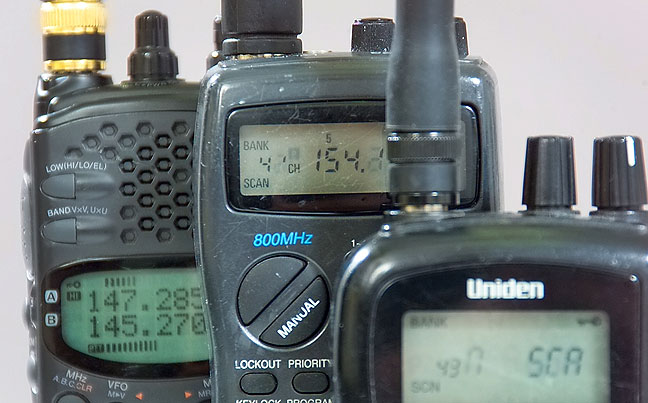
I have made a few antennas in my day, like the occasional j-pole or quarter wave, but I was never all that into it. I am actually pretty good at identifying antennas on towers and vehicles.
As I was driving to Utah a few years ago, I had lots of time on my hands, so I decided to make a list of all the police scanners I have owned. It was no small number, due in some part to improvements in technology and changes in the scanning environment, but also due to scanners wearing out and dying. Sometimes even boredom takes a role, and I’ll pick up a scanner as a bargain from a pawn shop or a garage sale just to play with it.
I have a vague recollection of picking up some scanner traffic on an analog multi-band radio I got as a birthday gift when I was a young teenager. I was 15, because I noted it in my journal. “Does this subject want to breath or bleed?” I quoted in my writings. The question was asked to determine if a DUI suspect wanted to take a breathalyzer test or a blood test. I suspect this was on an unpublished frequency, since my radio didn’t pick up the UHF band used at the time by Lawton police. That was my first experience with listening to public safety communications.

In 1982, I got an internship in a newspaper in Lawton, and there was a scanner in the newsroom, and one in each of the cars the paper owned that we photographers used. I recall that one of the scanners was the venerable Bearcat III 8-channel crystal-controlled units, and the other a 16-channel programmable. They were getting long in the tooth even then, with the emergence of better microprocessor-controlled scanners, but they got the job done, since Lawton only used about four frequencies on a regular basis.
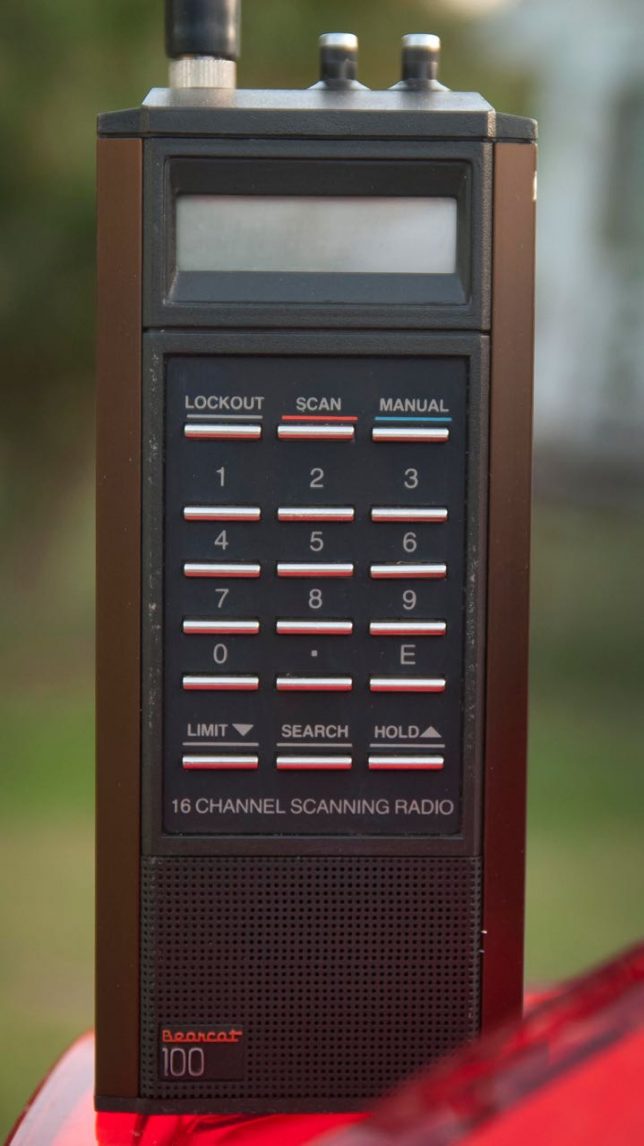
I was so enamored of the notion of “spying” on the police and fire departments (which prior to that I thought was illegal) that for my July birthday I asked for a scanner, and my parents obliged. Thus began a hobby that has lasted to this day. The list of scanners I owned throughout the years goes something like this (red ones are dead):
- Bearcat BC-150, 10 channel (birthday gift 1982.)
- Realistic Pro-21 4 channel crystal scanner (scanned VHF great, but very poor for UHF, which it was supposed to do. I had the front end readjusted a couple of times, which didn’t really help.)
- Bearcat III, 8 channel crystal (garage sale, installed in my first car, a 1973 VW.)
- Bearcat BC-100, 16 channel, the first ever programmable handheld scanner (bad battery setup, bad antenna design. I later got one from Ebay just for kicks.)
- Fox BMP 10/60 10 channel, died decades ago, replaced with a half-working copy from Ebay for$20 in 2023; red LED display plus red LEDs for each channel, with Service Search (installed in VW and later Renault Alliance.)
- Radio Shack Realistic Pro-2001, 16-channel, acquired in 2023 for $30 from a guy who called it “untested,” but it works fine. Interesting hybrid of crystal-controlled-style LEDs for each channel plus red LED display on the face.
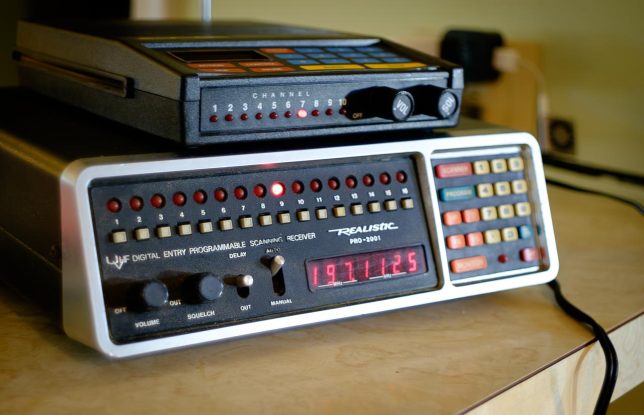
- Radio Shack Realistic Pro-31, 10 channel handheld (big radio that uses six AA batteries, hard to carry, but nice and loud.)
- Realistic Pro-37, 200-channel handheld. Regarded as one of the best handheld scanners in 1987, I got one from Ebay in 2022. Uses six AA batteries.
- Realistic Pro-2006, 400 channel base station. Regarded as one of the best base station scanners in late 1980s, I got one from Ebay in 2022. Sticky keys meant I had to open it up several times to spray with tuner cleaner, but it mostly works. Electroluminescent display is sketchy.
- Realistic Pro-2004, 300 channel base station. This was regarded as the base station scanner to own in 1986, so I got one from Ebay in 2022. It turned out that bad soldering during production meant none of these work any more. It looks good in my stack, however.
- Radio Shack Pro-2021 200 channel. I bough this radio new in 1986 when it got marked down and discontinued, but despite the fact that it scans too slowly, it receives well and is loud and clear. I had it my car for a short time in the early 1990s, and it currently resides in the garage. In early 2024, I saw one in mint condition on Ebay for $25 and bought it, so I have two of these.
- Cobra SR-15 100 channel handheld (with leather case, one of the best handhelds I ever owned.) Update: in 2020, I found one of these for $10 on eBay and bought it for its nostalgia value. It looks great but doesn’t run well.
- Regency MX-3000 80 channel (slanted front, blue display, worst receiver circuit of any I owned.)
- Uniden BC760XLT 100 channel mobile. Good audio, good form for car mounting. But mine forgets all it’s frequencies when power is interrupted, so I have relegated it to single-channel listening and band searches.
- Uniden Bearcat BC560XLT 16-channel with 2-digit display x2 (very cheap, good speaker – one was destroyed in a crash in 1990.)
- Sporty’s Pilot Shop A300 aviation band transceiver.
- Icom IC-A3 aviation band transceiver given to me by a ham radio buddy.
- Uniden 500 UBC9000XLT 500-channel (most expensive scanner I even bought, died within three years.)
- Radio Shack Pro-2026 200 channel
- Bearcat BD144XL 16 channel (pawn shop, gave to a friend.)
- Radio Shack Pro-23 50 channel handheld (bought for next to nothing from a coworker.)
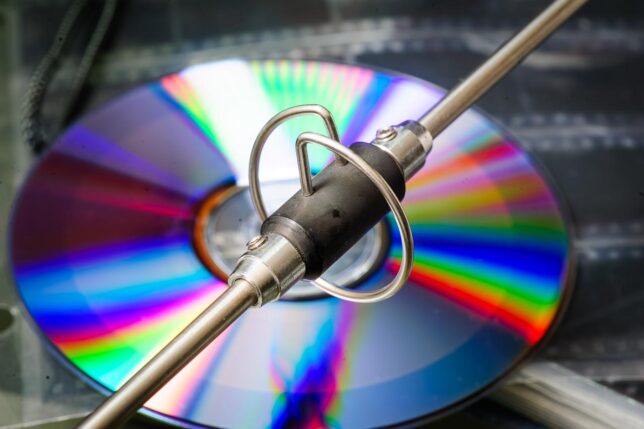
- Radio Shack Pro-94 1000 channel handheld (confusing “trunk” radio programming, terrible battery performance, tinny audio), in 2024 I gave it to Jamie and Ian.
- Radio Shack Pro-2035 1000 channel
- Radio Shack Pro-2039 200 channel
- Alinco DR M06TH 6-meter amateur (not really a scanner, but will scan 30-50 Mhz in addition to 6m; at home, fed by Cushcraft AR-6)
- Cherokee AH-50 6-meter amateur handheld (not really a scanner; 6m; not in use.)
- Radio Shack HTX-202 and HTX-404 handheld 2m and 70cm transceivers (not scanners)
- Icom IC-2820H, great, very capable dual band amateur radio with full scanning ability, including tone squelch; my primary news-gathering radio in my Nissan Juke
- Icom IC-2350H amateur dual-band + public safety, installed as a second radio in the Nissan Juke
- Icom IC-207H amateur dual-band + public safety, currently in my stack in the house
- Icom IC-V8000, a high-wattage 2-meter radio mounted in the Nissan Frontier
- Kenwood TH-79A amateur handheld + public safety
- Kenwood TH-22A amateur handheld + public safety
- Uniden BD175XL 16 channel (given to me by Abby’s late father)
- Radio Shack Pro-2030 80 channel
- Radio Shack Pro-2028 50 channel
- Uniden BC72XLT “Nascar” handheld 100 channel (one of the best handheld scanners I own because of its small size and good audio.)
- Uniden BCT75XLT 300-channel handheld scanner, given to me by Robert Stinson, who bought it and two others at a thrift store, giving one to Scott and one for himself as well.
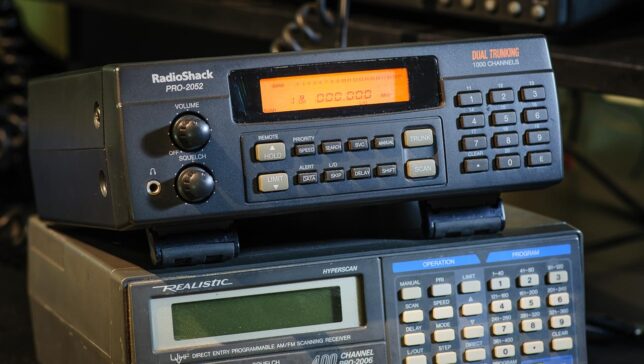
- Radio Shack Pro-2055. After installing an additional quarter-wave on the roof, I poked around a couple of pawn shops and found this radio for next to nothing.
- Radio Shack Pro-163. This radio is very similar to the Pro-2055.
- Radio Shack Pro-2020 20-channel scanner of 1978 vintage, bought from Ebay for its nostalgia. I took it apart and cleaned it out with contact cleaner, which was a chore, but which worked. I paid about $10 for it. It is the heaviest and largest scanner I own, maybe 10 pounds and the size of a cassette deck.
- Radio Shack Pro-2002, a 50-channel radio, also as a bargain from Ebay.
- Icom IC-2200H. I got this from a pawn shop for $80.
- Baofeng UV-5R multi-role transceiver. This tiny radio is all the rage, so I bought one in June 2019 for next to nothing to see what the fuss was all about. Read it’s review here (link). I had three of them, but the red one seems to have disappeared.
- Uniden Pro501HH Citizens Band radio. I got this recently after patiently scouring garage sales, estate sales, and used equipment websites like Ebay, with no luck at all finding anything CB at all. I don’t expect to use it a lot, but the tipping point for me was learning that Jeep events still use Citizen’s Band.
- Radio Shack DX-394 all-mode communications receiver, bought on eBay in 2023 as a replacement for my long-dead DX-400, which got done-in by corroded batteries.
- Radio Shack HTX-212, 2-meter mobile, bought from “silent key” auction from the Pontotoc County Amateur Radio Association.
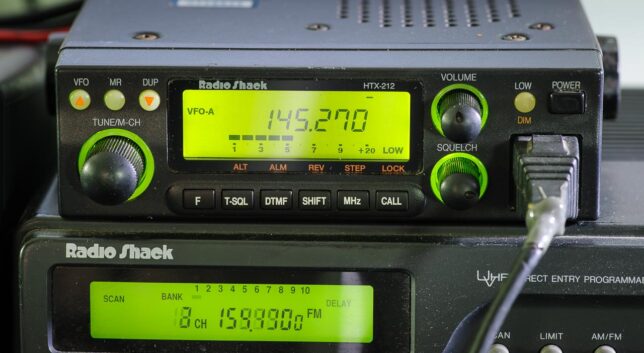
- Radio Shack Pro-2052, 1000-channel scanner, bought from “silent key” auction from the Pontotoc County Amateur Radio Association.
- Radio Shack Pro-91, 150-channel handheld scanner, Pontotoc County Amateur Radio Association, won’t power up.
- Tram 1400, 5/8λ over 5/8λ UHF collinear, silent key auction; put it up outside.
- Diamond NR790A, three-section dual band (2-meter and 70-cm) collinear; put up outside.
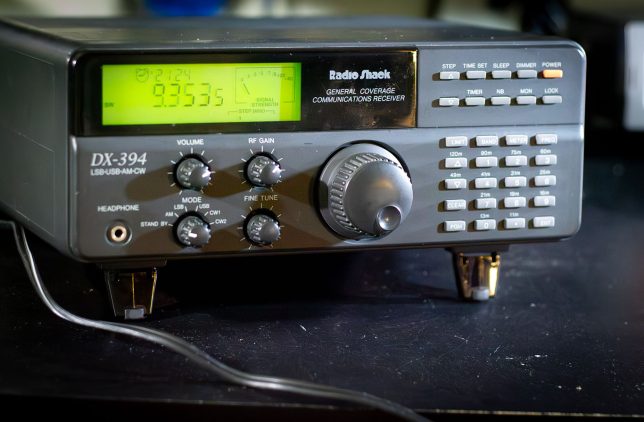
I had a few Citizen’s Band (CB) radios over the years, and found them to be just as useless as most of the internet is today, littered with vulgar, ignorant, undisciplined chatter.

My wife was annoyed by the daily chatter of the scanner, but I am able to filter it very effectively, and my ears perk up every time I heard a code that corresponds to something that might be newsworthy, like an injury accident, house fire, missing person, high-speed chase, severe weather, and more. The best example of my brain filtering scanner traffic was one night in March 2000. I kept the scanner on at a very low volume level, so that I could barely hear the routine comms, but sirens or urgent voices would wake me, as did, that night, the very urgent words, “The roof of the Ada Evening News is on fire!” After hearing that, I was downtown covering one of Ada’s biggest fires, of the Evergreen Feed Mill, in about three minutes.
So as long as I am able, I’ll be listening.
My main source for scanner frequencies is http://www.radioreference.com/
